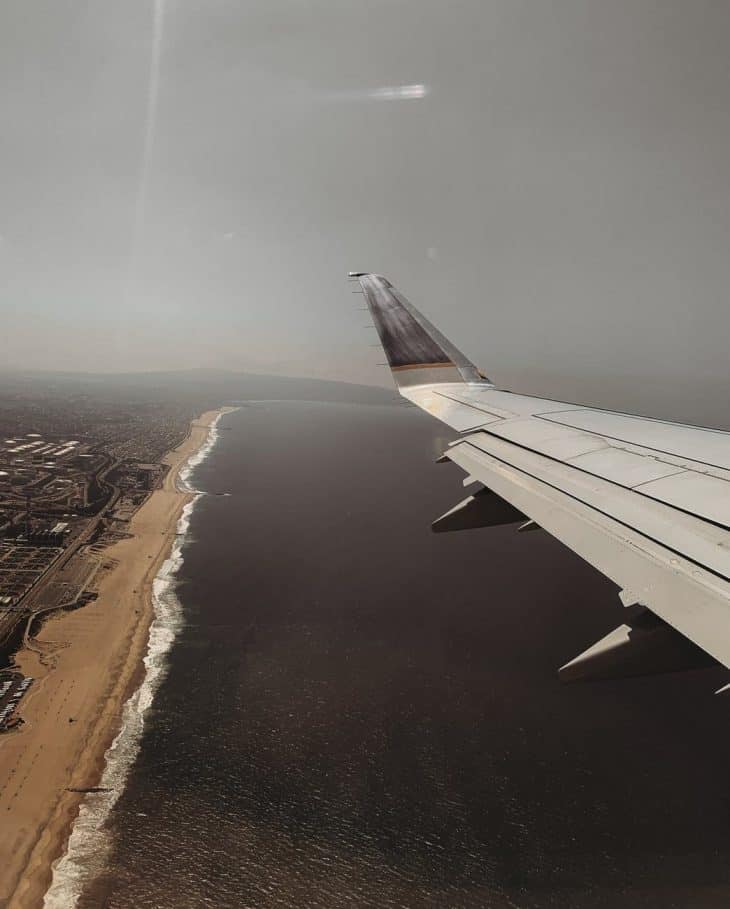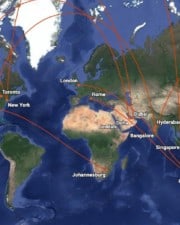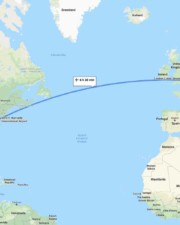Maybe you’re someone who has to be dragged kicking and screaming onto a plane and spend the flight petrified with fear. Maybe you’re a frequent flier who practically lives in the air. Either way, turbulence is your enemy, which begs the question – which flight paths are the smoothest and safest and have the least amount of turbulence?
To a certain extent, the answer to that question is and always must be subjective in terms of evaluating what counts as a “rough” flight and which flights feel “worse” than others.
What’s more, whether or not turbulence is even a “problem” for you can be highly subjective as well. After all, turbulence from a passenger perspective is the cabin of the aircraft shaking and all that might come along with that.
How Much Does Turbulence Bother You?
For some, the plane may be shaking like a scene out of an action movie, and it may not be enough to disturb them from their slumber or complimentary cocktails (unless the latter gets spilled on them, ruining the former, of course).
For others, the tiniest bit of turbulence may feel to them like that aforementioned action movie nightmare and have them saying their prayers while everyone else wonders what’s wrong with them.
The fact is, there’s nothing “wrong” with them, because turbulence is, to a great extent, subjective.
Inasmuch as we can measure and compare them, these are the top 11 least turbulent flight paths.
The Least Turbulent Flight Routes

1. Flights Away From Mountains
Those who are not involved in flight may not realize what an important role the topography and geography of an area plays to the turbulence and overall potential “roughness” of a flight.
That is because the whole precept of flight has to do with lift plus thrust, the former of which depends on air hitting the plane in general and underside of the wings in particular in just the right way.
While the mountains below may seem far removed from a flight path, in reality, air whistling through them can be forced upwards at a different angle than in flatter areas. The difference of that angle as it strikes the underside of a plane’s wings may be responsible for turbulence.
Flights which avoid mountain ranges such as the Rockies, Alps, Andes, and Pennines tend to be among the smoothest.
Related Article:
2. Flights Over Calm Waters and Oceans
As is the case throughout this list, the calmer the conditions, the better the chances that the flight in question will be a calm one, which is what brings us to oceans.

Some ocean flights, such as Transatlantic and North Atlantic flights, can be quite troublesome. However, oceans are also about as mountain-free and flat as it is possible to be. If the waters over a particular patch of ocean are calm, therefore, the flight has a better chance of being turbulence-free.
This is yet one more reason why weather reports are so important for flight crews. The same patch of water can, depending on the weather, be calm and flat enough to allow for a smooth, turbulence-free flight, or be active and far more problematic.
3. Flights Toward Calm Weather Areas
It is no secret that one of the biggest causes of turbulence is rough weather. There’s nothing quite like the thrill of Transatlantic Pond-hopping, but there’s little turbulence that can compare with flights between New York and London, either.

London in particular is notorious for its stormy uncertain climate, and it costs them in terms of turbulence. As such, lovely though Trafalgar Square, the National Gallery, and Southwark may be, when it comes to smooth turbulence-free flights, flights into Heathrow or Gatwick aren’t the way to go.
Instead, it is better to embrace places and flight paths that are the polar opposite and boast calm climates instead.
4. Flights Away From the Equator
The same goes for flights around the Equator. While it is tempting to think of this area as home to less turbulent flight paths due to its warmer weather, those warmer climates also invite strong winds, tropical storms, and the occasional hurricane.
This once again has to do with the way in which the air strikes the plane in general and its underside and wings in particular. In areas where the weather is temperamental, such as London or the Equator, wind, jet streams, rain, and other forces can complicate matters.
As such, flights which may be considered among the calmest in terms of turbulence do not typically take place near the Equator.
5. Flights Over Flat Land
As is demonstrated by the example of mountains causing problems above, for those looking to avoid turbulence, it is vastly preferable to fly over flat land instead. Flight paths that go out of their way to avoid mountainous areas are often subject to less turbulence.

This is one reason why it is of the utmost importance for flight crews to carefully map out flight paths ahead of time, so as to try and take advantage of as much easy to fly over land as possible.
This results in a balancing act between trying to take the most direct path between two points and trying to find the most flat land over which to fly for purposes of reducing turbulence.
6. Flights Into the Plains States
They may get mocked as “flyover states,” but if it’s any consolation to places such as Nebraska, Kansas, the Dakotas, and other Plains States, they’re some of the calmest places to travel to and from turbulence-wise.
The Plains States get a break from turbulence for a couple of reasons described above. For one thing, the land that covers these states is, true to their name, filled with plains and thus very flat.
Flying over the Plains States means not having to contend with air moving through mountains and changing direction as it hits the underside of a plane’s wings. As stated above, this can be a key cause of turbulence. In flights over the Plains States, the land is flatter, and the airflow calmer.
What’s more, the weather tends to be calmer in the Plains States as well. While tornadoes, storms, and other inclement weather events are still possible, of course, the Plains States don’t tend to be as temperamental weather-wise as a place like London or Chicago.
7. Early Morning or Evening Flights
Sometimes, it is not just the location that factors into how turbulent a particular flight path may be, but likewise when the flight takes place. Passengers who are looking to avoid turbulence, therefore, would be well served to look for flights in the early morning and evening.

Wind speeds tend to be more reduced early in the morning, which helps make the turbulence less likely. In addition, storms tend to weaken at night, further reducing the risk of turbulence.
Both of these factors conspire to make flight paths which are undertaken earlier or later in the day a better chance to avoid turbulence than those with mid-day weather conditions.
8. Flights Away From Cities
This entry onto the list may cause some confusion, because surely most flight takes place with commercial planes going to and from cities. It is not as though most planes are flying to an open patch of land in Wyoming.
However, those who suffer from a severe fear of turbulence may wish they did, because cities can cause some of the same problems regarding air hitting the plane at odd angles as can mountainous regions.
That is because skyscrapers and similar large buildings can cause the same issue in terms of air direction. The air whistles through these buildings and then comes upward at angles which can make it difficult on planes in terms of turbulence.
9. Flights Over the Middle East
This is another example of the weather and natural conditions of an area being used to the benefit of flight crews when planning out their flight paths for smoother flights.

While the Middle East has a lot of different areas, and there are plenty of more mountainous regions, there is still plenty of dry, open desert land over which pilots can fly for a more turbulence-free flight.
That said, this alone does not clear pilots of potential problems. For one thing, desert storms and similar occurrences can not only cause turbulence, but severe navigation problems for pilots as well.
10. Flights Over Parts of Africa
Africa may seem like an unlikely place to be considered as being an area of calm and stability, but that is the case for flight crews when it comes to some of the larger desert areas on the continent.
These places tick all the boxes necessary to reduce the risk of turbulence. These areas are flat, tend to be dry year round and, thus, don’t experience storms for much of the time, and are away from the mountains.
Of course, with as much stereotyping about Africa as there already is, it is vital to note that just as not every African group is the same, so too are Africa’s climates vastly different. The continent is also home to Mt. Kilimanjaro and much of the world’s rainforests, after all.
11. Flights Over the American Southwest
Los Angeles is the polar opposite of a city like London in many ways, not least due to its weather, climate, and the turbulence it experiences in flight paths – or lack thereof. Compared to London’s stormy, often turbulent skies, flights into Los Angeles and its calmer desert climate trend more smoothly.

That extends to other cities in that region of the Continental US as well. Flights to drier, calmer areas such as Los Angeles, Phoenix, and dry flat non-mountainous areas within the American Southwest are all good examples.
In trying to find the least turbulent flight routes, therefore, it is necessary to get as far away from that kind of weather as possible and instead embrace calm weather routes that do not feature these issues.
For example, although Los Angeles tends to be an easier place from which to fly than London, there have still been instances out of LA to other parts of the Pacific, such as Seattle, that have experienced turbulence so severe as to necessitate an emergency landing.
References ▾
Related Posts










